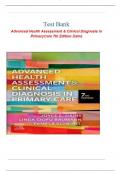Exam (elaborations)
TEST BANK- Advanced Health Assessment & Clinical Diagnosis in Primary Care (7th Edition,2024) Joyce E. Dains|| WITH CORRECT ANSWERS||ALL CHAPTERS
TEST BANK- Advanced Health Assessment & Clinical Diagnosis in Primary Care (7th Edition,2024) Joyce E. Dains|| WITH CORRECT ANSWERS||ALL CHAPTERS TEST BANK- Advanced Health Assessment & Clinical Diagnosis in Primary Care (7th Edition,2024) Joyce E. Dains|| WITH CORRECT ANSWERS||ALL CHAPTERS TEST ...
[Show more]



